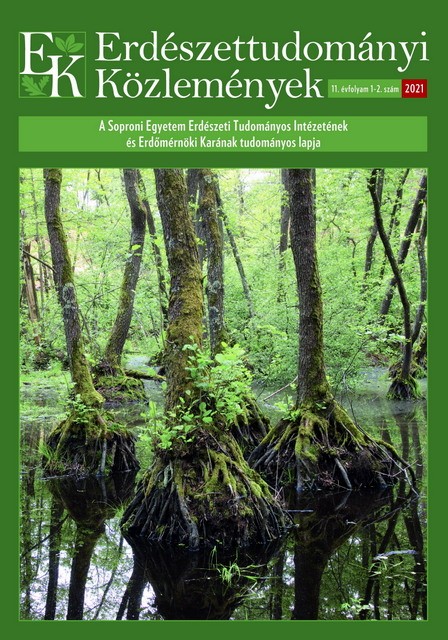| 1. | Alexander J.M., Naylor B., Poll, M. Edwards P.J. & Dietz H. 2009: Plant invasions along mountain roads: the altitudinal amplitude of alien Asteraceae forbs in their native and introduced ranges. Ecography 32: 334–344. DOI: 10.1111/j.1600-0587.2008.05605.x |
| 2. | Apollonio M., Andersen R. & Putman R. 2010: European ungulates and their management in the 21st century. Cambridge University Press, New York. |
| 3. | Arnold J.M., Gerhardt P., Steyaert S.M.J.G., Hochbichler E. & Hacklander K. 2018: Diversionary feeding can reduce red deer habitat selection pressure on vulnerable forest stands, but is not a panacea for red deer damage. Forest Ecology and Management 407: 166–173. DOI: 10.1016/j.foreco.2017.10.050 |
| 4. | Auffret A.G. & Cousins S.A.O. 2013: Humans as long-distance dispersers of rural plant communities. – PLoS ONE, 8, 62763. DOI: 10.1371/journal.pone.0062763 |
| 5. | Bartuszevige A.M. & Endress B.A. 2008: Do ungulates facilitate native and exotic plant spread? Seed dispersal by cattle, elk and deer in northeastern Oregon. Journal of Arid Environments 72(6): 904–913. DOI: 10.1016/j.jaridenv.2007.11.007 |
| 6. | Borhidi A. 1993: A magyar flóra szociális magatartás típusai, természetességi és relatív ökológiai értékszámai. A Környezetvédelmi és Területfejlesztési Minisztérium Természetvédelmi Hivatala és a Janus Pannonius Tudományegyetem kiadványa, Pécs, 95 pp. |
| 7. | Burst M., Chauchard S., Dupouey J.-L. & Amiaud B. 2017: Interactive effects of land-use change and distance-to-edge on the distribution of species in plant communities at the forest-grassland interface. Journal of Vegetation Science 28(3): 515–526. DOI: 10.1111/jvs.12501 |
| 8. | Christen D.C. & Matlack G.R. 2009: The habitat and conduit functions of roads in the spread of three invasive species. Biological Invasions 11(2): 453–465. DOI: 10.1007/s10530-008-9262-x |
| 9. | Csontos P. 2010: A természetes magbank, valamint a hazai flóra magökológiai vizsgálatának új eredményei. Kanitzia 17: 77–110. |
| 10. | Dukes J.S. & Mooney H.A. 1999: Does global change increase the success of biological invaders? Trends in Ecology & Evolution 14(4): 135–139. DOI: 10.1016/S0169-5347(98)01554-7 |
| 11. | Gervilla C., Rita J. & Cursach J. 2019: Contaminant seeds in imported crop seed lots: a non‐negligible human‐mediated pathway for introduction of plant species to islands. Weed Research 59: 245–253. DOI: 10.1111/wre.12362 |
| 12. | Ginnett T.F., Owens M.K., Cooper S.M. & Cooper R.M. 2001: Effects of deer feeders on home range size, use of space, and vegetation utilization of white-tailed deer. Pages 46-47 in Texas Chapter The Wildlife Society. Annual Meeting Abstracts. College Station, Texas. |
| 13. | Heltai M. & Sonkoly K. 2009: The role and opportunities of feeding in game management (Review). Animal welfare, ethology and housing systems. Volume 5, Issue 1. 22 p. |
| 14. | Honnay O., Verheyen K. & Hermy M. 2002: Permeability of ancient forest edges for weedy plant species invasion. Forest Ecology and Management 161: 109–122. DOI: 10.1016/S0378-1127(01)00490-X |
| 15. | Horváth F., Dobolyi Z. K., Morschauser T., Lőkös L., Karas L. & Szerdahelyi T. 1995: FLÓRA adatbázis 1.2. Taxonlista és attribútum-állomány. MTA Ökológiai és Botanikai Kutatóintézete, FLÓRA munkacsoport és a MTM Növénytára, Vácrátót, 267 pp. |
| 16. | Kiss R. 2016: A talaj-magbank szerepe a magyarországi növényközösségek dinamikájában és helyreállításában – A hazai magbank kutatások áttekintése. 21(1): 116–135. DOI: 10.17542/21.116 |
| 17. | Koncz G., Török P., Papp M., Matus G. & Tóthmérész B. 2011: Penetration of weeds into the herbaceous understorey and soil seed bank of a Turkey oak-sessile oak forest in Hungary. Community Ecology 12(2): 227–233. DOI: 10.1556/ComEc.12.2011.2.11 |
| 18. | Kosowan A. & Yungwirth F. 1999: Canada thistle survey summary. East Boreal. Ecoregion, Saskatchewan Environment. |
| 19. | Mathisen K.M., Buhtz F., Danell K., Bergström R., Skarpe C., Suominen O. & Persson I.L. 2010: Moose density and habitat productivity affects reproduction, growth and species composition in field layer vegetation. Journal of Vegetation Science 21: 705–716. DOI: 10.1111/j.1654-1103.2010.01180.x |
| 20. | Mortensen D., Rauschert E., Nord A. & Jones B. 2009: Forest Roads Facilitate the Spread of Invasive Plants. Invasive Plant Science and Management 2(3): 191–199. DOI: 10.1614/IPSM-08-125.1 |
| 21. | Parendes L.A. & Jones J.A. 2000: Role of Light Availability and Dispersal in Exotic Plant Invasion along Roads and Streams in the H. J. Andrews Experimental Forest, Oregon. Conservation Biology 14: 64–75. DOI: 10.1046/j.1523-1739.2000.99089.x |
| 22. | Ramsfield T.D., Bentz B.J., Faccoli M., Jactel H. & Brockerhoff E.G. 2016: Forest health in a changing world: effects of globalization and climate change on forest insect and pathogen impacts, Forestry: An International Journal of Forest Research 89: 245–252. DOI: 10.1093/forestry/cpw018 |
| 23. | Rinella M.J., Dean R., Vavra,M. & Parks C.G. 2012: Vegetation responses to supplemental winter feeding of elk in western Wyoming. Western North American Naturalist 72: 78–83. DOI: 10.3398/064.072.0109 |
| 24. | Selva N., Berezowska-Cnota T. & Elguero-Claramunt I. 2014: Unforeseen Effects of Supplementary Feeding: Ungulate Baiting Sites as Hotspots for Ground-Nest Predation. PloS one. DOI: 10.1371/journal.pone.0090740 |
| 25. | Spurrier C. & Drees L. 2000: Hostile takeovers in America: invasive species in wildlands and waterways. Transactions of the 65th North American Wildlife And Natural Resources Conference 65: 315–325. |
| 26. | Wilson C.E., Castro K.L., Thurston G.B. & Sissons A. 2016: Pathway risk analysis of weed seeds in imported grain: A Canadian perspective. NeoBiota 30: 49–74. DOI: 10.3897/neobiota.30.7502 |
